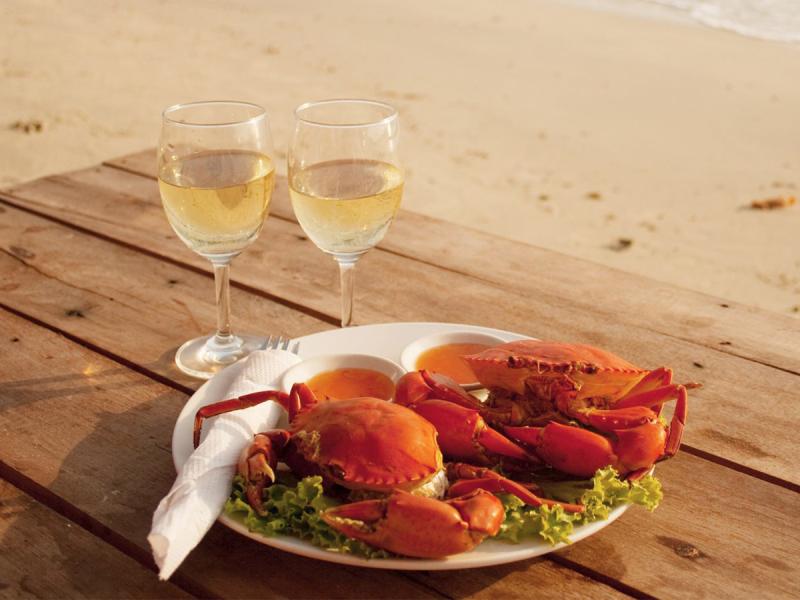Rías Baixas is a Spanish wine region that has been getting some play lately, and rightfully so! Albarino is a lovely, dry, refreshing, seafood-friendly white wine which, in most cases, will run you less than $20. Rías Baixas, which means Lower Rias, is located in the southwest coastal area of Spain, above Portugal, on the Atlantic Ocean nestled into the confluence of four river valleys. Locals name it the Green Spain. There are five wine regions encompassed there. Val Do Salnes, the oldest of these, is reputed to be the birthplace of varietal Albarino. The estuarine mixture of fresh and salt water making up this basin is somewhat similar to the Chesapeake, and the variety of seafood available is extensive.
In addition to scribbling, I read extensively regarding food. I’ve always found it fascinating how people have adapted their grapes to the terroir and the indigenous food supply. History suggests that humans have known about genetic modification since well before Charles Darwin. There is absolute written cuneiform evidence from the Ashurbanipal library in Nineveh, 650 BCE, that they improved grains and livestock through selective breeding. I had help translating the tablets (lol!). By the way, cuneiform was only a written language. Most spoke Chaldean. Sorry, blah blahed too much.
Pazo de Senorans Albarino 2018 can be found under $18, 92 McD. I love its bouquet of apricot and peach with a hint of honeysuckle. On the smooth, medium-bodied palate look for more peach supported by mineral acidity. Folks who drink Viognier will definitely enjoy. Senorans is only a 20-year-old winery, but winemaker Ana Quintela knows her stuff. Natural fermentation in stainless ensures freshness, and aging sur lie provides body and spice to the clean finish. Those who wish to go upscale can check out their Seleccion de Anada 2008. Pale green-tinted gold with a huge mixed bouquet of peaches, white plum, citrus and slightly toasted, it is supported by very mildly salty minerality. Thirty months on lees in stainless prior to bottling provide body, spice and longevity; 93 McD points under $60, drinking window thru 2025. The $18 label is always a safe bet. The worst rating I have applied was 89 points for 2009. More recent vintages of the Anada will run you about $40. Don’t be confused – Albarino, although white, is made to cellar.
Bodega Colomé Estate Torrontes 2018 from the Salta region, under $12, is another Hess family production. Famous winos are unsure of the origin of the three strains of Torrontes named Sanjuanino, Mendocino and Riojano. All three do well in the high-altitude vineyards near the Cafayate region of Salta. Although Spain also produces Torrontes in Galicia, many claim it is uncertain the varietals are related. Look for peaches, green apples, some floral hints. Fresh acidity supports the bouquet. Very dry with a clean mineral finish, 90 McD add 2 price points when you buy a case around $120. This will make your “ahrsters” exceptional next holiday season. Carry a few bottles on down to Georgetown. Be sure to lift a pinky when sipping from your crystal stemware.
Although the weather outside has been frightful recently, inside it’s been quite delightful with my paw wrapped around a cold glass of Marco Felluga Molamatta Collio Bianco DOC 2015. This label is nothing but consistent. I have rated it 88-89 since 2000 with the exception of a 90 in 2006. The 2015 is blended of Pinot Bianco, Tocai Friulano and Ribolla Gialla. Straw-colored with dried fruit, coconut and chamomile bouquet that is promoted due to cold maceration and stainless fermentation of 60 percent Tocai and Gialla, and oaken spice from the fermentation of 40 percent Pinot Bianco in barrels. Allowing the wine to rest sur lie about 16 months provides creamy body supported by proper acidity. I have a bit of an issue paying $27, but I find myself going back to it on many occasions. It always gets good reviews when served with white fish or shellfish. Best bet for the dog days of August in Delaware or Maryland – gather some locally grown, ripe stone fruit like peaches, nectarines or white plums and toss in some figs or raspberries or blackberries to make a fruit salad. Choose ripe fruit; hold the dressings and sugar. The Albarino provides the balancing acidity. Please wear your Sybarite suit to the table.



















































